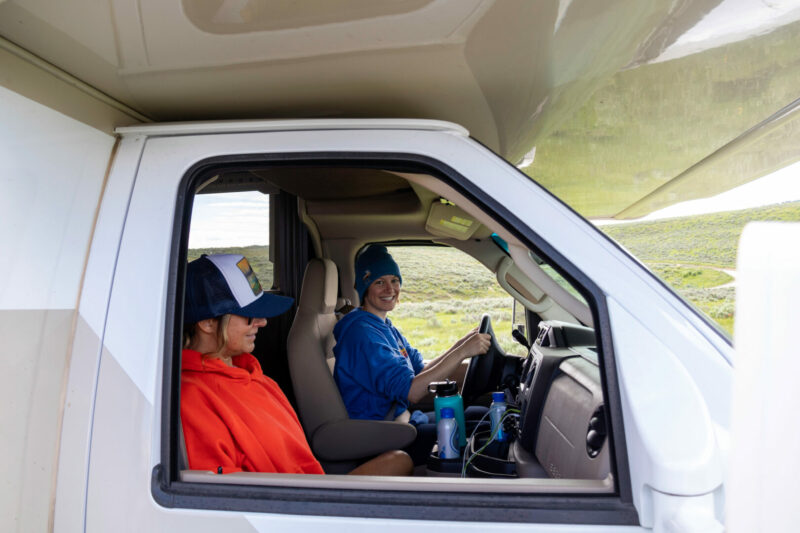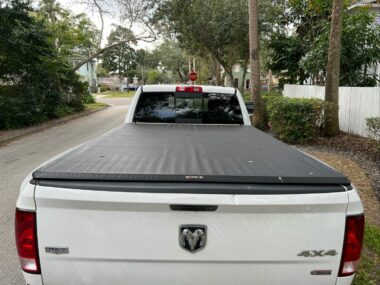Table of Contents Show
For most automobile drivers, the thought of driving an RV through city streets or along interstate highways can seem daunting. But with a little practice and a sense of adventure, anyone can conquer the roads in an RV. From camper vans to truck-based vehicles and huge buses, these rigs are not as frightening as some think.
New to RV Driving? We’ve Got You Covered
If you have never driven an RV, we have put together a guide to alleviate your reluctance. Follow the suggestions below and start to feel a little better about driving your new RV.
Is It Hard to Drive an RV?
Many prospective RVers let fear hold them back from traveling in an RV. They panic at the thought of driving a big Class A rig or a fifth-wheel across the nation or into a campsite.
But, in reality, with some practice, you can maneuver a recreational vehicle easily. Of course, many long-time drivers have plenty of advice to give, and the instructions can change with the size of the camper.
However, the easiest way to learn is to take your RV to a large, empty parking lot and spend some time driving your RV, making turns, backing into parking spots, and working with a spotter.
You can find several good YouTube videos that teach you about “waiting until the object you want to turn around is at your hip before starting a turn” and “beware of your rig’s overhang.”
With the major differences between RV types, it is best to follow instructions from someone who has the same type and size vehicle as you.
Do You Need a Special License to Drive an RV?
You don’t need a special license to drive most recreational vehicles. Because driver’s licenses are issued based on the size of the vehicle you drive, almost all RVs come under the weight limit of 26,000 lbs.
Anything over that weight requires a commercial driver’s license (CDL). Additionally, if you carry more than 16 people in your RV, you must qualify for a CDL.
Some Super C RVs or recreational vehicles driven by a semi weigh above 26,000 lbs, but you will find that most rigs fall in the 8,000 to 14,000 lb range. So you’ll usually only need a standard license for typical motorhomes, travel trailers, and fifth wheels.
However, practice driving any large vehicle before taking them on your first camping trip.
Before You Drive: What to Know About Your RV
Before jumping behind the wheel, understand some of the basics about how your RV works and things that will make your learning experience more useful. Here are some things to know.
Clearance & Width
You must know the measurements of your RV for several reasons. Some bridges have low clearances. Trying to drive your RV under an overpass can have serious consequences.
Save yourself some grief by memorizing the height of your rig (including air conditioners and vent covers) and use mapping tools or a GPS to guide you away from low clearance locations.
You also must know the width of your rig when coming across toll booths. Sometimes, you’ll have tight space between each booth, making drivers of large vehicles nervous about their approach.
So be prepared with your width measurement. You might once again rely on GPS or trip planning software to route you around toll roads if you think you might have a problem.
And one of the most useful reasons for knowing your vehicles all around measurements is for reserving campsites. Many RVers guess their length with booking at a campground. This is not helpful to you or the campground managers, as they may have sites with various lengths or widths. Knowing your exact measurements, including your slideouts, can make or break your stay.

Adjustment Your Mirrors
We have a few tricks for adjusting RV mirrors, including flat and convex mirrors that show you more of the road on either side and behind your RV. Those towing a trailer or fifth wheel might have to add camper mirrors to their tow vehicle. All of these devices help you drive safely.
RV Geeks has created a helpful video that teaches you how to adjust and mark where your mirrors can aid you. It will give you insight into blind spots, lane changes, merging and turning, and how to anticipate them.
You can also watch other good instructional videos from RV Education 101 and other capable teachers. Each has handy tips for using your mirrors effectively when driving your RV.
Get Comfortable
Do a walk-around on the exterior of your vehicle, checking to see that everything looks good. Put down all antennas, disconnect hoses, and unhook the electricity.
Putting the captain’s chair in a comfortable position, aligning your mirrors, and tuning in to your favorite radio station or playlist can help you get ready to hit the road.
Ensure that all items in the coach get stowed away safely. And because you have practiced driving, turning, and parking before this inaugural trip, you can now feel prepared to head off toward that first campground.
Pro Tip: If you need help remembering all the steps to prepare your RV for a trip, check out these printable guides to help keep you organized and prepared!
Practice, Practice, Practice
Practice makes perfect, and the same goes for driving an RV. Find an empty parking lot and take a friend with you to help spot.
Then practice driving and stopping at different speeds. Mark a parking lane and practice backing into it, replicating a back-in campsite. And above all else, practice turning your rig.
Try Out Some Turns
Many instructors tell new RV drivers to approach a turn by looking at the object they want to clear, such as a stop sign.
As you approach the corner, don’t start your turn until the stop sign has aligned with your hips. This will make your turns much easier, especially the right-hand ones, which seem to throw Class A drivers for a loop.
Also, know how much overhang your rig has from the back tires to the coach. If your overhang is long, some of your RV moves over the object when you turn, so you may have to compensate with a wider turn. All of this will become second nature as you practice, practice, practice.
Back It Up
You will need to back up your RV sometimes, so practicing this maneuver while in an empty parking lot will come in handy on your camping trips. Make sure you can pull into a parking space and practice backing in at an angle.
You’ll come across some campsites positioned on an angle. Have someone spot you and learn common hand motions for backing and turning the wheel.

Watch the Tail Swing
The tail swing equates to the amount of overhang your rig has between the back wheels and the rear end of the RV. If you cut a right turn too short, that overhang can run into items on the corner.
So you must learn how much of a tail swing you have and how wide a turn you must make to compensate for it when driving your RV.
Practice Parking
If a patient friend will practice with you, spend some time practicing parking. No matter where you take your RV, you will always need to park it, whether at a campsite or an attraction along the way.
Some RVs won’t fit in standard parking spaces, so you will need to adapt accordingly. Much of the skill comes from backing up when necessary, so make sure you utilize your mirrors and a backup camera, if available.
Put your friend to the test as a spotter and someone who might direct you in turning your steering wheel in the right direction.
General Rules of the Road
The wide variety in RVs means they’ll have many different maneuvers. However, general driving rules for RVs stay mostly the same. They involve some common sense and a bit of attention:
Stay in the Right Lane
We have all driven behind a slower-moving truck or RV camped in the left lane. Don’t be that guy! It slows traffic for others and can make it difficult for people to pass you.
Only use the left lane when you need to pass another vehicle, then move to the right as soon as it is safe.
Keep Your Distance
With vehicles weighing up to 14,000 lbs, you can’t just stop on a dime. Leave plenty of space between you and the car or truck in front of you. Anticipate stopping by watching the traffic ahead and begin stopping early, if possible.
Practice in an empty parking lot. Have a friend mark where you start your immediate stop by placing a parking cone or object at that spot. Then ask them to mark where your vehicle comes to a complete stop.
This will give you a good visual of how long heavier vehicles take to stop moving. Also, be prepared for items in your rig to become dislodged in making this maneuver.

Downshifting Is Your Friend
Learning how to downshift when driving your RV will help you control your rig and utilize more power when needed when going up or down steeper inclines. Using a slower gear instead of the brake pads on a downhill slope can also alleviate some wear and tear on your vehicle’s brakes.
Additionally, many RVs come with “overdrive,” forcing your camper or tow vehicle to use less acceleration or maximum power. This will provide better fuel economy and a more effortless driving experience.
Signal Early
Because RVs have large blind spots, let the traffic around you know that you plan a turn long before it arrives by using your blinkers and brakes.
Recreational vehicles have a more difficult time maneuvering quickly, so you must plan ahead for lane changes and turns. Give those around you time to make space for you.
Consider RV Driving School
If all of that practice still leaves you feeling a bit inadequate, you can attend an RV driving school that offers more intense practice with capable instruction.
RV Driving School offers private one or two-person two-day lessons, which take place entirely in the cab of your RV. They have competent instructors located all over the country and can even schedule classes at your own location.
Because driving an RV shares many similarities with driving a semi, Southwest Truck Driver Training offers courses in piloting one. This training also happens in your RV rather than a classroom, so you get hands-on experience.
If you live on the east or west coast, Texas, or Chicago, you may want to enroll in RV Basic Training classes. They offer two different courses, teaching the specifics of driving a motorhome or towing a trailer. Although it includes written manuals, you will spend your entire time learning behind the wheel of your RV.
Building Your RV Driving Confidence
Don’t miss out on enjoying the camping lifestyle because the thought of driving an RV distresses you. You have many options to overcome that uneasiness. Practice, take a driving course and watch some videos to help you get started.
With training, learning about your rig, and lots of practice, you can easily handle any camper on the road today.






